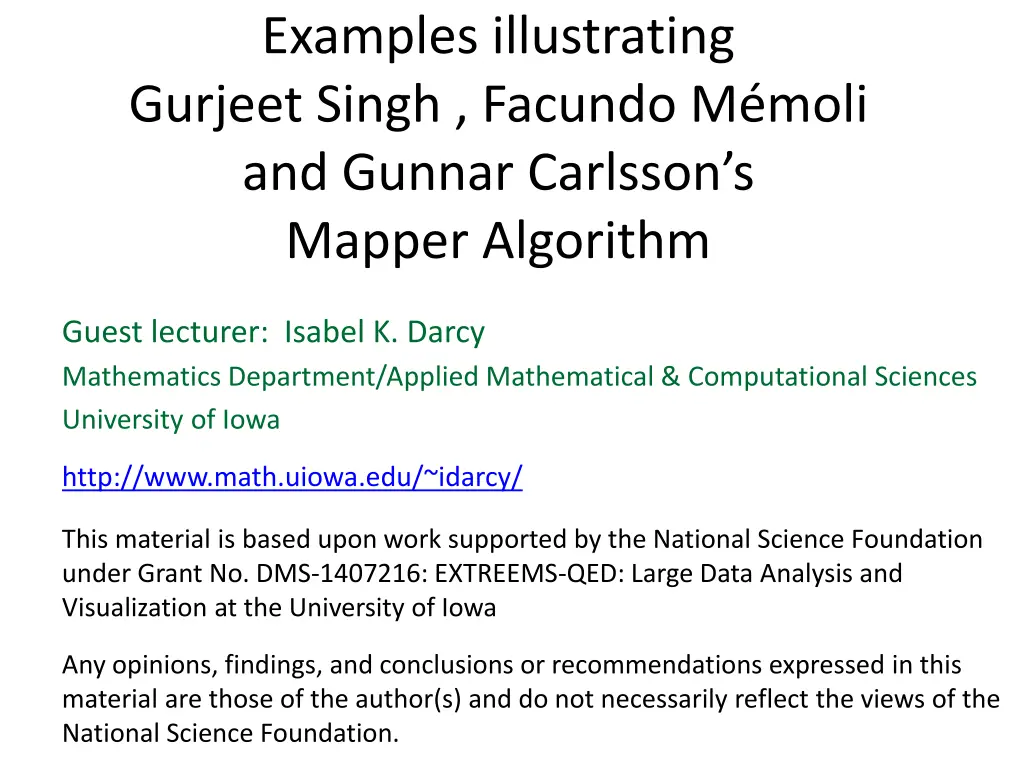
Understanding Mapper Algorithm for Data Visualization
Learn how Gurjeet Singh, Facundo M. Moli, and Gunnar Carlsson's Mapper Algorithm can be applied to data visualization through examples. Discover the process of putting data into overlapping bins, clustering each bin, and creating a graph to represent the dataset.
Download Presentation

Please find below an Image/Link to download the presentation.
The content on the website is provided AS IS for your information and personal use only. It may not be sold, licensed, or shared on other websites without obtaining consent from the author. If you encounter any issues during the download, it is possible that the publisher has removed the file from their server.
You are allowed to download the files provided on this website for personal or commercial use, subject to the condition that they are used lawfully. All files are the property of their respective owners.
The content on the website is provided AS IS for your information and personal use only. It may not be sold, licensed, or shared on other websites without obtaining consent from the author.
E N D
Presentation Transcript
Examples illustrating Gurjeet Singh , Facundo M moli and Gunnar Carlsson s Mapper Algorithm Guest lecturer: Isabel K. Darcy Mathematics Department/Applied Mathematical & Computational Sciences University of Iowa http://www.math.uiowa.edu/~idarcy/ This material is based upon work supported by the National Science Foundation under Grant No. DMS-1407216: EXTREEMS-QED: Large Data Analysis and Visualization at the University of Iowa Any opinions, findings, and conclusions or recommendations expressed in this material are those of the author(s) and do not necessarily reflect the views of the National Science Foundation.
To understand software, it helps to apply it to a variety of examples.
What graph do you get when you apply mapper to the ideal trefoil knot if filter = projection to x-axis? ( ( ) ( ) ( ) ( ) ( ) )
1.) Put data into overlapping bins. ( ( ) ( ) ( ) ( ) ( ) ) Example: f-1(ai, bi)
Put data into overlapping bins.
Cluster each bin. Each cluster is represented by a vertex.
Create a graph representing the data set: Cluster each bin. Each cluster is represented by a vertex. Draw an edge between 2 vertices if their clusters have points in common.
Create a graph representing the data set: Cluster each bin. Each cluster is represented by a vertex. Draw an edge between 2 vertices if their clusters have points in common.
D C B A E
A E D C B
2 3 4 1 A E D C B
3 2 1 4 A E D C B
4 1 3 2 E D A B C
D 2 C 3 4 B A E 1 A E D C B 4 3 1 2 1 4 3 2 A E E D D A C B B C
4 1 3 2 E D A B C
What graph do you get when you apply mapper to the above blob if filter = projection to x-axis?
To understand software, it helps to apply it to a variety of examples.
http://www.nature.com/srep/2013/130207/srep01236/full/srep01236.htmlhttp://www.nature.com/srep/2013/130207/srep01236/full/srep01236.html
